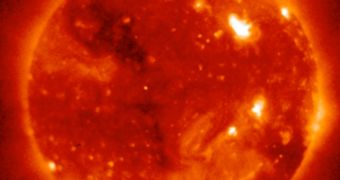A series of glitches and an overall anomalous behavior prevented experts at the American space agency from bringing the Solar X-Ray Imager instrument aboard the GOES-15 satellite to a fully-functional state until now. After the Geostationary Operational Environmental Satellite-15 took off on March 4, the observer was supposed to be brought online as soon as possible, but this goal could not be achieved until just recently, when NASA engineers managed to crack the problems. Now, after months of delays, the instrument sees its “first light,” officials at the agency announce.
“Since the early checkout of GOES 15 (P) and the anomalous turn on of the Solar X-Ray Imager, the team has been aggressively pursuing all avenues to recover the instrument. Frankly, we were down to our last straw when all the teams' hard work and efforts finally paid off. We now believe we have a full recovery of the instrument's functionality! It's an incredible story and a true testament of our NASA/contractor teams expertise, hard work and determination,” says of the accomplishment expert Andre' Dress. He is the deputy project manager for the GOES N-P mission, and is based at the Goddard Space Flight Center in Greenbelt, Maryland.
The satellite was thoroughly investigated following the anomalies in the X-ray imager. Engineers from both NASA and the US National Oceanic and Atmospheric Administration (NOAA) worked as hard as humanly possible to look into every possible scenario that may have triggered that outcome. “We were facing a tough problem when we first attempted to bring SXI on line. But because of our ability to bring together subject matter experts from both government and industry, to move forward step by step, and to work as a team patiently and persistently, together we achieved mission success. This is an enormously satisfying outcome,” says SXI program manager George Koerner.
He works for the company that designed and built the Solar X-ray Imager, Palo Alto, California-based Lockheed Martin Space Systems Company (LMSSC) Advanced Technology Center (ATC). The satellite blasted off from the Cape Canaveral Air Force Station (CCAFS), in Florida, aboard a Delta IV delivery system. It took it about a month to undergo testing and commissioning, and its instruments managed to capture the first visible image of Earth on April 6. About three weeks later, it was able to take the first full disk image of the Sun in infrared wavelengths.
The infrared equipment on GOES-15 is of tremendous practical importance, especially to meteorologists and weather forecasters. Observing the planet in these wavelengths enables these experts to gain more data on temperatures on the ground, in the sea and in the air, as well as to derive various other data. For example, they can calculate wind, temperature and moisture profiles for the atmosphere, and can observe how smoke plumes – such as those from volcanic eruptions – migrate across the surface of the planet. The IR instruments can also be used to monitor wildfires, experts add
The Solar X-Ray Imager was eventually brought online on June 3. After days of calibrating and testing the tool, the team finally decided that its voltages were within optimal parameters, and decided to take it out for a ride. “I don't think most people realize how important these space weather instruments are in our everyday life. This data is used by the US Department of Defense, NOAA, NASA, and the Federal Aviation Administration (FAA) in protecting our space assets, land based assets and directing flight paths for the FAA,” Dress reveals.
GOES-15 is the third and last addition to the GOES N-P Series of spacecrafts, which include only geostationary environmental weather satellites. At this point, the two operating instruments in the system provide coverage for about 50 percent of the planet's surface, sending back valuable data to help with weather prediction and disaster management.

 14 DAY TRIAL //
14 DAY TRIAL //